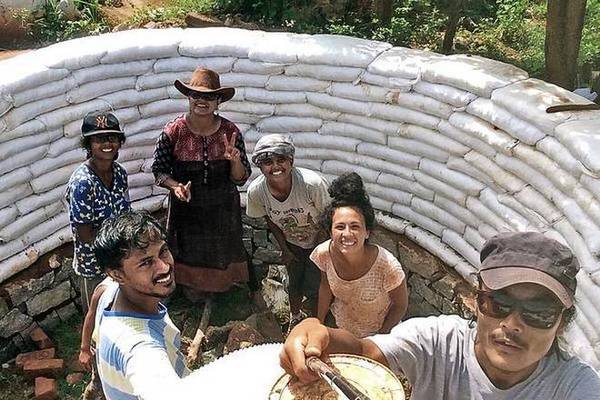
S. Samyuktha’s new house under construction at Valukkaparai is a little different from the usual – it has no bricks or cement. An architect by profession, Samyuktha was always interested in sustainable architecture and implemented the concept of Earthbag construction for her house.
“After completing my architectural course in 2014, I did a self-designed learning course in Udaipur, India. There, I got the opportunity to do several projects of my interest. This house also started off as a part of it. I have a team of civil engineers, architects and volunteers who are helping me build it”, she says. Samuktha has used the circle as a basic shape as it is “structurally strong.” With a total of five rooms, this 1000 sq ft project has used around 3000 polythene bags. “I planned to recycle used bags. It did not happen as finding strong bags was difficult. I wanted bags which were not affected by sunlight, and hence had to buy the bags from the market”.
Samyuktha says that using mud for construction is traditional way across regions especially in earthquake prone zones. “Here we have used it with a contemporary twist.” Sacks are filled with the soil and beaten to remove excess moisture and make it hard.” Samyuktha has also added barbed wires in between rows of earth sacks to create friction. “We work from seven in the morning to two in the afternoon, depending on the weather.
The construction started three and a half months back. The walls are complete and it is all done by my team and volunteers. We did not hire any labours, except for the foundation.” She is planning to do the plastering using lime, mud and sand. “The flooring will be mud, and the roof will be of Mangalore tiles. There will also be a dome at the centre, which will also be made of earthbags.”
She claims that the earthbag construction has a lot of advantages. “It is not very labour intensive. Anyone can do it. It is cheap when compared to the brick and cement houses and provides thermal comfort. The temperature inside the structure will be several degrees cooler than the outdoors. With time, the walls will also become stronger.”
Not too many people bought into her idea, says Samyuktha. Only once the construction progressed, people changed their opinions. “There are people asking us if we can help them build something similar for them.” She says what she learnt in the process of executing this project far exceeds what she learnt from her college text books. “I love the experience” she laughs.
To volunteer or for more details, contact 9487548163 or visit on Facebook.
Read more at the Hindu.com
Visit our main website at Earthbag Building.com for complete information.

Sir
Want to build in nilgirs any body can help me.hp 91-44-9381199019
Thanks in advance
Saravanan
Hello sir’I run a rented hotel in Tabo Himachal Himachal Pradesh India basically i am from Nepal. I loved your idea of earth bag house but I want to use this idea for business purpose I want to build earthbage rooms for guest. Because in winter it’s very cold here so earth bag house can be good insulater. So I want to know how much it will cost to build a 15×15 feet bed room and 6×5feet bath room
The cost can be as low as a few thousand dollars. It all depends on how fancy you want it. Contact Good Earth Nepal (now Good Earth Global) in Kathmandu. They provide free training that includes hands on experience. Take a couple of your workers so they also learn. They know where to buy the bags, tubes, tools in Kathmandu. Use their method because it’s earthquake resistant. http://goodearthglobal.org/